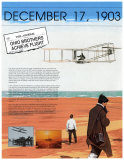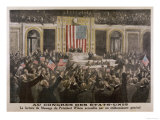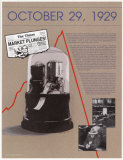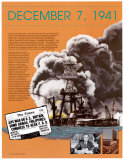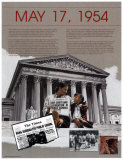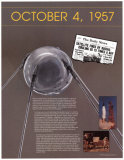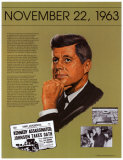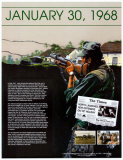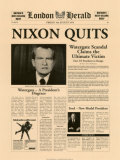|
|
Ten Days that Shook the Nation Educational History Posters
for the history and social studies classrooms and home schoolers.
|
social studies > history > TEN DAYS POSTER SERIES
|
|
The educational history “Ten Days that Shook the Nation” poster series commemorates ten days that shook the United States in the 20th century: First Flight of the Wright Brothers, World War I, 1929 Stock Market Crash, World War II, Brown v Board of Education, Sputnik, JFK Assassination, 1969 Moon Landing, Vietnam War, and Nixon’s Resignation.
|
|
|
December 17, 1903 -
Ohio Brothers Achieve Flight
Ever since Icarus donned his wings of feathers and wax, humans have dreamed of flying. But as the 20th century began, few believed people would ever fly through the air. But two young men from Dayton, Ohio, knew better. Their names were Wilbur and Orville Wright. The Wright brothers first became interested in powered flight after reading about the pioneering glider pilot Otto Lilienthal. Soon, they began experimenting with gliders and kites as their own design. On the advice of weather experts, they chose a narrow strip of sandy beach near Kitty Hawk, North Carolina for their experiments.
In the summer of 1902, the Wrights successfully tested a glider at Kitty Hawk. The next fall, Orville and Wilbur returned to Kitty Hawk with a gas-powered plane thay had built for less than $1,000 (roughly $27,000 in 2013). They were so confident that this plane would work, they sent a telegram to their father, “Success assured. Keep quiet.” But bad weather and minor technical problems kept their plane grounded until December 17th. That day, the two brothers flipped a coin to see who would make the historic first flight. Orville won. The flight was anthing but spectacular, covering only 120 feet and lasting a mere 12 seconds. But that short trip was to change the nation - and the world - forever.
Soon, the skies over America were filled with strange flying contraptions. Only 11 years after Kitty Hawk, the world's first scheduled airline was operating in Florida. By the 1950s, airliners were making daily non-stop flights across the Atlantic. Today, U.S. airlines log over 400 billion miles every year! Our ability to fly anywhere in the world - at a moments notice - has brought people from all cultures together, and made our world a smaller, less mysterious place.
Theodore Roosevelt was US President.
• aviation posters
|
|
|
|
|
|
|
|
|
|
December 7, 1941 -
World War II
The morning of December 7, 1941, dawned clear and cold. Though World War Two was more than two years old, for most Americans it remained a remote war. On that afternoon, may Americans were engaged in a weekly habit - listening to the New York Philharmonic give its Sunday coast to coast radio concent. Suddenly, at breathless voice broke in: “One moment please.” There was a brief pause, and then: “The Japanese have attacked Pearl Harbor, the United States naval base ... in the Hawaian Islands.” At that moment, the war became more than background noise for Americans, it became a national cause - a cause that would eventually claim nearly 300,000 American lives and cost roughly $300 billion.
On December 8, the United States entered the conflict and most destructive war in history. But as tragic as World War Two was, U.S. entry into the war did have two positive long-range effects on the nation. First, the massive war effort pulled America out of the depths of the Great Depression, which had left the U.S. economy in a shambles. Secondly, with a single thrust Pearl Harbor deflated the growing isolationist movement in America. Before that infamous December afternoon, most Americans were content to stay put of the world's troubles. But by the time the war ended four years later, the United States was the world's dominant economic power and one of its two greatest military powers. The establishment of the United Nations in 1945 symbolized the new U.S. role as “the world's policmen” - a role that our nations has played, sometimes reluctantly, ever since.
Franklin Delano Roosevelt was US President.
|
|
|
|
|
|
|
October 4, 1957 -
Sputnik - Satellite Fired by Russia: Circling US 15 Times a Day.
The first artificial Earth satellite (a natural satellite is a celestial body that orbits another body) - was launched by the now former Soviet Union. The launch, shattering the US perception itself of being the technological superpower superior to the backward the Soviet Union, spurred an emphasis on science and technological research and reforms in US military and education systems.
Dwight D. Eisenhower was US President.
• more Space posters
|
|
|
|
November 22, 1963 -
Kennedy Assassinated; Johnson Takes Oath
It took only six secconds for Lee Harvey Oswald ...
|
|
|
|
January 30, 1968 -
The Vietnam War
North Launches New Offensive on Tet Holiday
Lyndon Baines Johnson, President
|
|
|
|
|
|
|
August 9, 1974 -
Nixon’s Resignation
Nixon Resigns - He Urges a Time of “Healing”; Ford Will Take Office Today.
|
|
|
previous page | top
|
|
I have searched the web for visual, text, and manipulative curriculum support materials - teaching posters, art prints, maps, charts, calendars, books and educational toys featuring famous people, places and events - to help teachers optimize their valuable time and budget.
Browsing the subject areas at NetPosterWorks.com is a learning experience where educators can plan context rich environments while comparing prices, special discounts, framing options and shipping from educational resources.
Thank you for starting your search for inspirational, motivational, and educational posters and learning materials at NetPosterWorks.com. If you need help please contact us.
|
|
|












